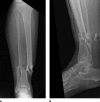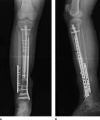Novel Surgical Approach to Segmental Bone Transport Using a Magnetic Intramedullary Limb Lengthening System
- PMID: 30192254
- PMCID: PMC6221376
- DOI: 10.5435/JAAOS-D-17-00487
Novel Surgical Approach to Segmental Bone Transport Using a Magnetic Intramedullary Limb Lengthening System
Abstract
Posttraumatic bone defects (BDs) remain a difficult complication for orthopaedic surgeons. Surgical goals in these reconstructive cases are to create stable limb fixation, maintain limb length, and provide adequate soft-tissue coverage. Historically, surgical approaches in these cases have required the use of an external fixator, which is associated with several postoperative complications. A plate-assisted bone segment transport (PABST) technique using a magnetic limb lengthening system eliminates the need for an external fixator and is effective for these reconstructive cases. A 51-year-old male patient presented as a category I trauma after a motorcycle collision. Osseous injury was defined as Gustilo-Anderson type IIIB distal tibia and fibula fracture (AO 42-C2). After fixation failure, the PABST technique was performed using a magnetic intramedullary limb lengthening system. Radiographic union was achieved 18 months postoperatively. This innovative surgical technique is effective in treating posttraumatic BDs without the need for limb shortening or the use of an external fixator. PABST has the potential to decrease postoperative complications in BD reconstructive cases using all-internal technology designed for limb lengthening. PABST, in this instance, uses a magnetic intramedullary nail that is controlled with a hand-held external remote to allow for precise, adjustable, and bidirectional bone segment transport.
Figures




References
-
- Rigal S, Merloz P, Le Nen D, Mathevon H, Masquelet AC: French Society of Orthopaedic Surgery and Traumatology (SoFCOT). Bone transport techniques in posttraumatic bone defects. Orthop Traumatol Surg Res 2012;98:103-108. - PubMed
-
- Paley D, Catagni MA, Argnani F, Villa A, Benedetti GB, Cattaneo R: Ilizarov treatment of tibial nonunions with bone loss. Clin Orthop Relat Res 1989;241:146-165. - PubMed
-
- Masquelet AC, Begue T: The concept of induced membrane for reconstruction of long bone defects. Orthop Clin North Am 2010;41:27-37. - PubMed
-
- Catagni MA, Geurreschi F, Lovisetti L: Distraction osteogenesis for bone repair in the 21st century: Lessons learned. Injury 2011;42:580-586. - PubMed
-
- Ilizarov GA: Basic principles of transosseous compression and distraction osteosynthesis [Russian]. Ortop Traumatol Protez 1971;32:7-15. - PubMed
MeSH terms
LinkOut - more resources
Full Text Sources
Other Literature Sources
Medical
Miscellaneous

